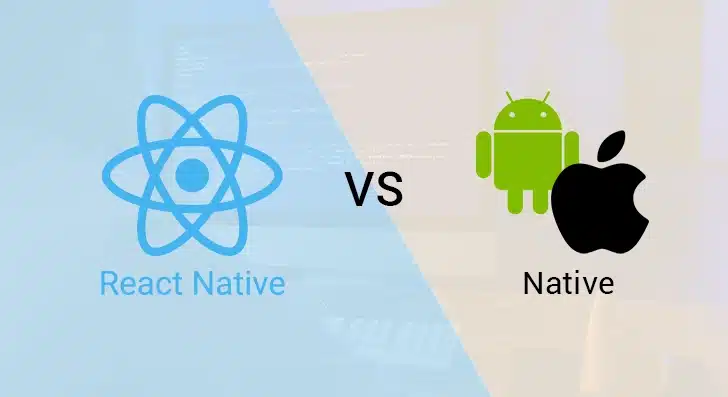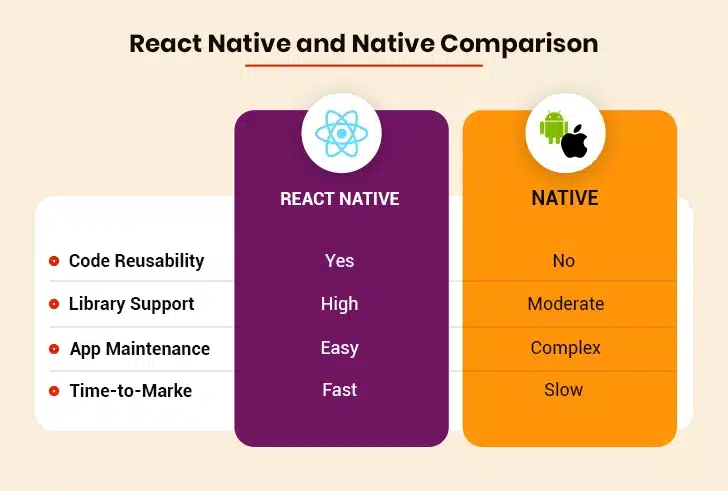 The future of a mobile application is shaped by the decisions you make along the way.
Over the last few years, the adoption of cross-platform mobile app development frameworks like React Native has been on a constant upward route. The React Native framework, built and maintained by Meta Platforms, has helped many brands to bring their innovative and platform-independent app concepts to reality. While React Native continues to gain popularity, some technocrats still advocate for the Native development approach. The Native programming languages and development tools offer the capability to build applications tailored to Android and iOS platform specifications.
Both development approaches have their own merits and distinctions. In the midst of this battle, if you are struggling to choose the right option, this article will be the right guide for you.
The future of a mobile application is shaped by the decisions you make along the way.
Over the last few years, the adoption of cross-platform mobile app development frameworks like React Native has been on a constant upward route. The React Native framework, built and maintained by Meta Platforms, has helped many brands to bring their innovative and platform-independent app concepts to reality. While React Native continues to gain popularity, some technocrats still advocate for the Native development approach. The Native programming languages and development tools offer the capability to build applications tailored to Android and iOS platform specifications.
Both development approaches have their own merits and distinctions. In the midst of this battle, if you are struggling to choose the right option, this article will be the right guide for you.
React Native vs. Native – Aspects to Consider for Determining the Right Approach
React Native and Native mobile app development are two development approaches predominantly used by various brands and businesses. However, if you’re new to the domain of mobile app creation, comparing these development approaches and weighing their benefits is a real struggle. To simplify this, here, we have listed the prime aspects to consider for making the right decision between React Native and Native development.1. Development Time
The foremost aspect to consider while comparing the React app vs the Native development approach is the development time. React Native The open-source React Native framework offers predesigned UI and UX libraries and plugins. By leveraging these libraries, you can reduce the time spent designing mobile app interfaces. The React Native framework supports code reusability. This means you can write a single codebase for iOS and Android application versions and reduce the development time. Native In Native application development, you need to write separate codebases for the iOS and Android platforms. For instance, Swift and Objective-C are programming languages that support code creation for iOS apps. Similarly, Kotlin and Java are optimal languages for Native Android app development. However, these languages do not support code reusability. You need to create and maintain separate codebases for both platforms. This increases the development time and effort. Verdict: If you want to market your app in a minimal turnaround time while influencing the platform’s audience, go with React Native.2. Library Optimization
Another aspect that helps compare Native app vs. React Native development is library optimization. React Native A common misconception is that the UI libraries offered by the React Native framework are less customizable and incapable of delivering custom views and animations. However, that is not the case with the latest framework version. The UI libraries in the React Native framework are built around modular architecture. You can tailor and optimize the UI libraries according to Android and iOS platform specifications. This enables you to build mobile apps that render custom and consistent views, transitions, and animations across iOS and Android devices. Native By embracing the Native development approach, you can reduce the time taken for library optimization. It’s because the UI libraries offered by Native programming languages like Swift and Kotlin are upgraded and optimized by a community of developers. In other words, these libraries are highly compatible with iOS and Android platforms and facilitate responsive UI development. Verdict: Though both React Native and Native technologies excel at responsive UI development, determining the best bet is a bit difficult. You should opt for React Native when prioritizing building apps with advanced UI effects and properties. If you’re looking to reduce the UI library optimization time, then Native development should be your preferred development approach.3. Processing Power
Application processing power is the speed and efficiency with which a mobile app performs tasks and displays interface elements. It is a key aspect that you should consider during the comparison of React Native vs. Native development. React Native By leveraging the React Native framework for application development, you can ensure that your applications process and render UI elements without delays. This is because React Native apps rely on mobile devices’ GPU graphics processing unit to process and render visual UI elements. Besides, your React Native apps support easy integration with iOS and Android Native modules. This enables applications to access device functionalities like Bluetooth, background services, biometrics, and others. These features make your apps perform complex computational processes like video streaming, image processing, and face authentication without disruptions. Native Mobile applications built using Native technologies rely on the device’s CPU for UI rendering and computational process execution. This impacts your applications’ processing speed and efficiency when the workload increases. Verdict: If user experience and processing power are your priorities, you should consider leveraging React Native for mobile app development.
4. Library Security
Security is an essential aspect to keep an eye on when comparing Native mobile app vs. React Native app development. React Native React Native framework offers a range of third-party libraries and APIs related to authentication, data transmission, and authorization. These mechanisms enable you to secure the mobile application data and communication. However, these third-party libraries are vulnerable to cyber threats and attacks, increasing the chances of middle-man interruptions. That’s why evaluating the security of libraries before using them in app development projects is essential. With the help of dedicated React Native development experts, you can determine a library’s security through dependency analysis and perform essential modifications and upgrades. This step ensures that your React Native libraries and APIs are free from security risks before deploying them in applications. Native Apple and Google’s developer communities test and upgrade the libraries and APIs provided by Native programming languages. This minimizes the risk of utilizing obsolete or vulnerable library resources for app development. Verdict: Native programming languages ensure high security of APIs and libraries, which you can directly leverage for mobile app development. React Native offers a range of libraries and APIs for various app functionalities compared to Native programming languages. However, it’s essential to assess and validate the library’s security before utilizing them in projects.5. Cost of Development
The comparison of React Native vs. Native development costs also helps you select the right approach for your mobile app development project. React Native There’s no denying that the code reusability functionality of React Native reduces app development costs. Developing a single codebase for iOS and Android applications can reduce the cost of development by 30 to 40% compared to the Native approach. Native Native development requires leveraging multiple programming languages, development environments, and debugging tools for creating and maintaining separate codebases. This increases the development costs, time, and complexity. Not to mention, the separate codebase development requires you to hire and manage specialized iOS and Android professionals. This further increases the development costs and resource allocation. Verdict: If development cost is the prime factor, React Native is the optimal choice for you. Though we have listed the comparison aspects of React Native app vs Native app development, let’s explore when to adopt these development approaches.How React Native Framework Slashes the Development Costs in Half
When to Adopt Native App Development
Opting Native app development is ideal when:- You plan to build apps that require access to advanced device hardware mechanisms like GPS, gyroscope, accelerometer, and others.
- You want to deliver a better user experience to the audience of a particular platform.
- You are creating an app that functions even under minimal Internet connection support.
- Your goal is to deploy apps that remain compatible with the version upgrades of Android or iOS platforms.
- You have adequate expert resources to manage the development and maintenance of separate codebases of Android and iOS applications.
When to Adopt React Native App Development
Selecting React Native app development is optimal when:- You want to speed up the development time of cross-platform applications.
- You seek to market your products and services to the diverse Android and iOS audience.
- You want to launch apps that share the reusable codebase and incur low development costs.
- You want to build and deploy mobile applications with high processing power and low memory footprints. Some examples are ecommerce and social media applications.
- Your mobile application needs integration with various third-party APIs and plugins.
How React Native Framework Guarantees Smooth User Experience
Why React Native Development Is a High ROI Option
Recat Native development offers a time and cost-effective way to build and launch mobile applications without compromising performance. By lessening the development time, expenses, and maintenance efforts, Recat Native development approach offers a higher ROI than Native development. To give you clarity, here we have described how React Native development ensures a higher return on investment for your business than Native development. So here we compare React Native vs Native app development in the context of ROI.I. Deployment Time
In the context of Native development, writing separate codebases is essential to building and deploying a single application on iOS and Android App Stores. Separate codebase programming increases the application development and deployment time. The delay in development and deployment time hinders your business from marketing applications before competitors and acquiring market attention before competitors. On the other hand, React Native’s code reusability and library support help accelerate application development. This rapid development contributes to reducing deployment time and generating quick revenue opportunities in a minimal duration.II. Reach
When compared to Native development, React Native development enables you to improve the application’s reach. Launching a single codebase application in Android and Apple stores can increase your app’s downloads and utilization base. This higher reach enables your business to generate returns through subscriptions, advertisements, and in-app purchases.III. Maintenance
Modifying and upgrading separate Native codebases requires more time and resources for maintenance. On the other hand, React Native development makes it easier for your developers to modify, upgrade, and debug codebase simultaneously. This is because of the single codebase and React Native’s support for Hot Reloading functionality. Simplified app maintenance enables you to save costs and resources in the long term while ensuring high performance.IV. Serverless Architecture Support
In contrast to Native technologies, the React Native framework offers intuitive API support for serverless architectures like AWS Lambda, Firebase Cloud, and Google Cloud Functions. Integrating these APIs into your application can offload complex data processing and validation tasks to the serverless architecture. This eliminates the need to rely on third-party databases to manage complex data processes and save infrastructure overheads. Hence, in the comparison of React app vs Native development, the former is proven to be the profitable approach.Different Brands That Have Leveraged React Native for Mobile App Development
As stated before, various brands have acquired a robust market reputation by leveraging React Native for mobile application development. Here are some of the established apps built using React Native:| Walmart | The leading retail enterprise used the React Native framework to build its ecommerce applications. This enables them to share their app’s codebase and deliver advanced shopping experiences for users across both iOS and Android platforms. |
| Wix | Wix, the website builder mobile app is built using React Native. The app delivers a crash-free web creation experience for iOS and Android users and has a 4.5-star rating on the App Store. |
| Bloomberg | Bloomberg invested in React Native development to develop their business news reading app, ensuring a smooth reading experience for Android and iOS device users. |
| SoundCloud | The audio file streaming application is built on React Native framework and ensures smooth audio uploads and downloads for a diverse user base. |





